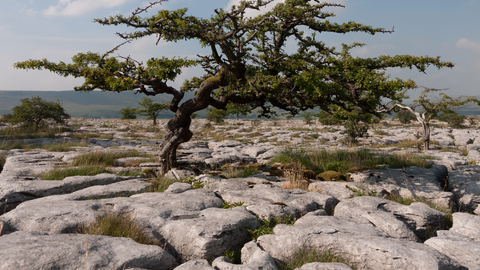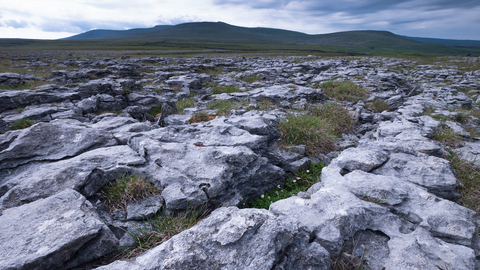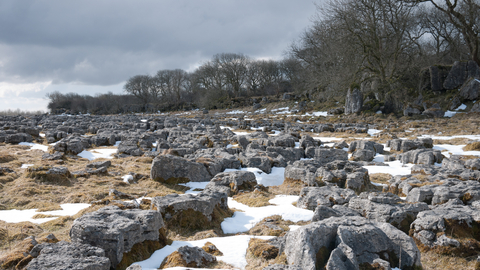


Limestone pavement
What is it?
Limestone pavement comprises exposed, flat expanses of Carboniferous, Dalradian and Durness limestone. The flat slabs of rock are scored with deep, undulating fissures (known as ‘grykes’). These can be up to 6m deep, although most are 1-2 m. Shallow erosion pans and pock marks are also found on the intervening blocks (‘clints’). Most limestone pavement is grazed, and the rock surface supports little if any vegetation. However, ferns and other plants typical of rocky habitats or woodlands flourish in the damp grykes out of the reach of grazing animals. A thin, well-drained turf of limestone grassland can develop around limestone pavement or in very shallow grykes. In some places, a regular pattern of hummocks and hollows reveals the hidden presence of limestone pavement under the turf. Where limestone pavement is ungrazed, it develops into an open form of upland mixed ashwood, and may retain a rich flora.
Why is it like this?
It is thought that limestone pavement was formed by the scouring action of glaciers on horizontally-bedded limestone. Grykes were probably formed by weathering and the action of rainwater on lines of weakness within the rock, although some deep grykes are considered to have been formed some 30 million years earlier during the Carboniferous period, when the landscape was probably wooded. Rainwater became more acidic as it filtered through the woodland soils, enhancing its ability to create “dissolution features” in the underlying rock. As grykes became bigger, soil washing into them may have vanished away into the underground cave systems characteristic of limestone country, revealing the rock. Human clearance of woodland and subsequent grazing speeded up this process.
Distribution in the UK
Around 3,300 ha of exposed limestone pavement is found in the UK, where it is confined to limestone country. Together, Britain and Ireland hold a significant proportion all existing limestone pavement.
What to look for
Limestone pavements are known for their botanical richness. Ferns cupped within the hollows of grykes are worth investigating, and a whole array of species may be found - look for limestone fern, rigid buckler fern and green spleenwort together with more common species such as hard shield-fern, male fern and hart’s-tongue. Look out for orchids in the middle of summer, including the rare dark-red helleborine. Baneberry prefers the shade of grykes, and woodland species can be found where there is a little more soil, including lily-of-the-valley, primrose and wood anemone. On warm days look out for pearl-bordered and high brown fritillaries.
Conservation
Most limestone pavement is heavily grazed, as it forms part of upland agricultural systems. However, lack of grazing may allow the development of hazel scrub and eventually woodland and a loss of key species of open pavement. In the past, substantial areas of pavement were destroyed through quarrying for “water-worn” limestone for gardens.
